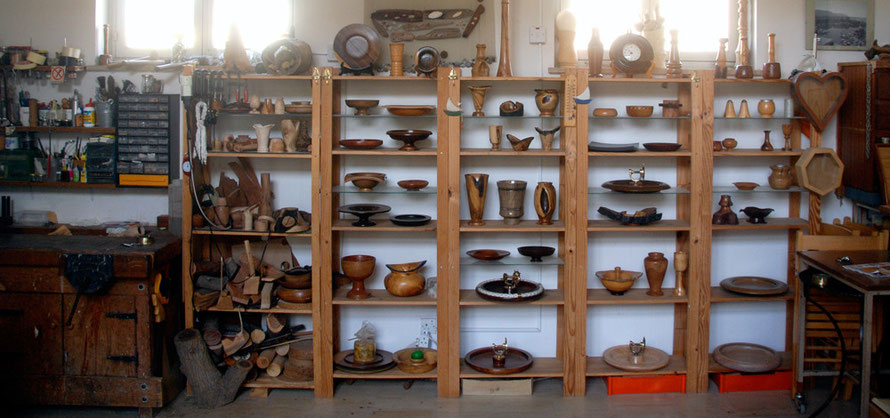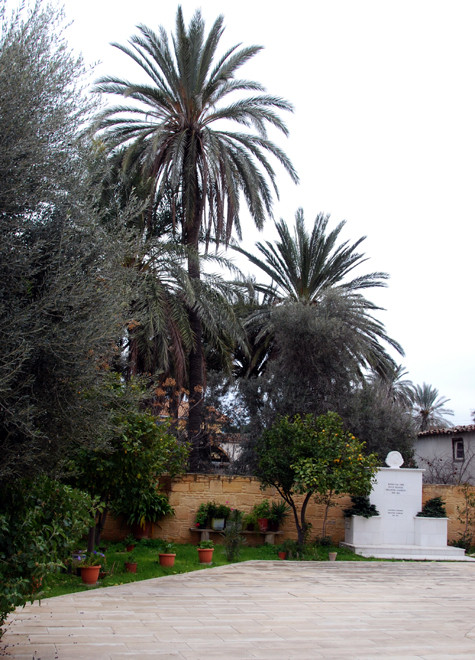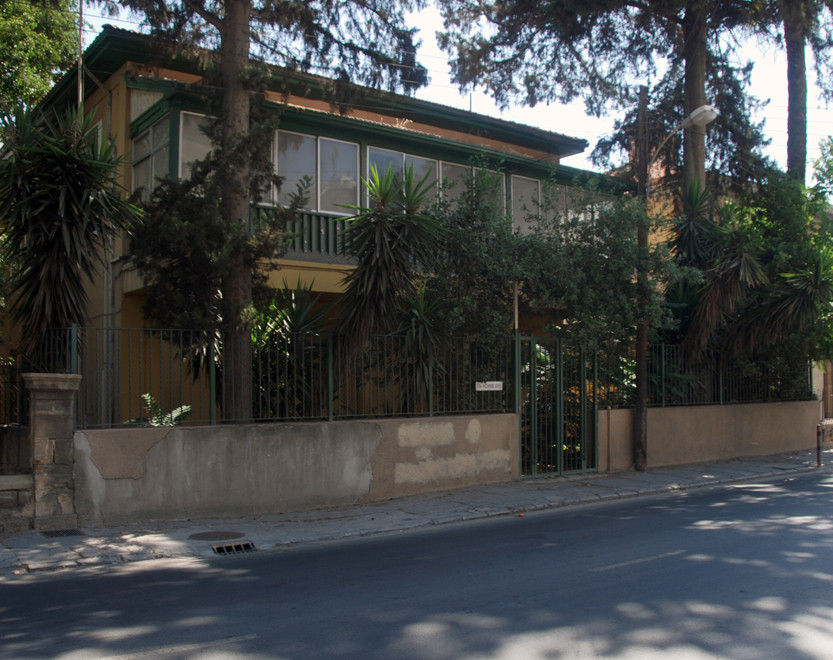Towns II: Old Nicosia (south)
An overcast and cold day in February, 2011. Bad weather has been gradually moving east across the Mediterranean. I'd thought about a trip into Troodos mountains but was warned off because of
snow. I was new in town. Fresh off the plane. My companions had gone to work and I was on foot.
I walked into Nicosia past the Agios Antonios market, which was small and uneventful. Close by was a long-fronted shop selling all sorts of barbecue equipment, plus bunches of loofers. At the junction was another such shop. Opposite was the impressive Agios Antonios primary school with a short avenue of palms to the front door.

I walked to the Venetian city walls and over the Potocatora bastion – where some kind of archeological work was going on. Returning as dark fell there were hundreds of birds roosting in the bushes - maybe goldfinches. The 'Liberty Monument' stands on Potocataro.
Erected in 1973, it is a marble monument overlooked by a goddess. Two dark bronze freedom fighters with machine guns pull up a portcullis that releases a group of people – men in suits, women, children, Greek Orthodox priests - from a prison-like tomb. A coach was disgorging little school kids in front of it for what looked like a propaganda visit.
The Rough Guide mentions that the statue was put up in 1973 and is now ‘such an embarrassing obstacle to communal reconciliation that it is unremarked on in most official tourist literature’ (p.250)
After all, EOKA,the Greek Cypriot guerilla group, were in some people’s eyes freedom fighters and in others right-wing anti-communist thugs. And whereas they may have held the Turkish army’s advance in 1974 they did not prevent the partition of the island and ethnic cleansing – indeed they were early advocates and enforcers of that cleansing.
To my eyes the monument glorified an alliance of Greek Cypriot forces of patriarchal conservatism – the church and EOKA. And yet EOKA B in 1974 had set out to kill Archbishop Makarios III with a brutal assault on his residence with shellfire and troops.

Beyond the Liberty Monument are the remains of a beautiful aqueduct to bring water into the town. This led, just behind the wall, to the Famagusta gate. On the old town side is a flour mill. Men were loading sacks onto a conveyor that took them into a battered old container on the back of a lorry. At the top a bloke stacked the sacks. The air was full of a yeasty smell of fermenting grain.

The Famgusta gate is massive, with a huge latticed door and two oval windows, deep set in honey-coloured limestone walls. Passing by it later, I went into the cultural centre that is now housed there. A young guy was on his mobile and the walls of the great arched cavern were filled with framed newspaper front pages. From the sign outside some kind of 50th anniversary was being celebrated but from the many pictures of suited men on the newspapers, it looked achingly dull. The gloomy space reminded me of the Tate Modern turbine hall in London and, like it, the floor sloped downwards.


I continued on my way, past a building site converting a big old shop that used to sell electrical appliances. In front of this was a curious monument – a square constructed stone column maybe 2 metres high. The dressed, chamfered stone was mortared-in and in some of the blocks a largish pebble or river-stone had been inlaid. At the top of the column there was a neck of mortar, with an collar of pebbles and on top of big rectangular gilded stone with a band of blue and white painted around it. I have not been able to work out what it signifies but it reminded me of the funerary stele at the Hala Sultan Tekke mosque.
I took a photo and moved on past the Club de Cuba and across the road into a park where the city wall used to be. The sun was out briefly and there was lots of bird song. I walked to the edge of the little park, with its empty paddling pools, and looked over a football pitch. I could see the gnarly bit of the Kyrenian Hills – the pentadaktlyos – the Five Fingers – that reminded me of Tryfan in Snowdonia. I was about to take a picture of it with the zoom extended when I realised I was also pointing the camera at a Greek Cypriot army post on the Green Line.
Leaving the park a sign said that the refurbishment of the Chrysaliniotissa quarter of Nicosia was being funded by the UN Development Fund and the US Fund for Overseas Aid.

This is a lovely district and is being painstakingly refurbished. I wandered down one of the streets that wasn’t dug up and happened across a courtyard arts centre with a small café - the
Chrysaliniotissa Craft Centre. I peered into dark windows and saw wood turners' and wood carver’s workshops.

In the café I got talking to the woman cooking vegetarian food. She turned out to be from Bergamo in Italy. I had a mint tea with 'Green Line' honey and sat out in the pallid sun. An old guy came to read the paper and have his morning coffee. I gave him a 'Kalemera' and he started talking to me in Greek. Using the word ‘English’ and my other two words of Greek – Efcaristo and Parakelou – I convinced him that I didn’t speak any more Greek. He was very friendly, all the same. I had hoped to talk to the wood carver – Simone – who normally turned up at 11.00. I called back later to no avail.
As I left the Italian woman pointed me towards Agios Kassionos. This is a lovely low-built Byzantine church in a small, bare square but for a few radiant orange trees.
Details of Agios Kassionos, Nicosia
I took a few photos of the church and a gargoyle that portrayed a strange furry creature that looked a bit like an otter. The church is made of hard, bubbly limestone that has a pinky hue. The old carvers made beautiful floral pillar capitals and door surrounds which have that dog-tooth patterning of English Saxon churches.
Around the corner, in the narrow streets, with their single storey houses, was another, even smaller church that was practically pushed into the back of the Green Line. There was no-one about and the sun had gone. This was Agios Giorgios, surrounded by palm trees. A beautiful old olive trees stands in the diminutive courtyard.
I was now feeling cold and walked faster towards the middle part of the old town. This is staggeringly rundown. Old shopfronts from the 70s stand dusty and empty. At one point I took a photo of a very rusted old sign advertising ICI paints which spoke of another era and a town centre abandoned to trauma and heartbreak.

The only trades that do seem to survive in what was once a busy shopping area are joinery and a few car bodyshops. The cavernous old Municipal Market – a sixties building of concrete – housed but a few traders and even fewer customers. I saw cinnamon bark being sold by the 5 euro bagful, and wickerwork. Just as I was leaving my eye was caught by a supermarket trolley being pushed by a butcher. Looking closer I realised that I was looking at a trolley full of skinned horses heads, their eyes bulging and lidless, their muscles and teeth bloody and exposed.

The bloody, ghastly spectacle of the horses heads seemed to sum up the terrible violence and hatred that erupted in Cyprus in the 1960s and 70s between and within the Greek Cypriot and the Turkish Cypriot populations. Needless to say I wanted to get a photo of such a potent image but I didn't have the cojones to front it out with the butcher man.
I continued on my way, by now feeling disoriented in the maze of crumbling streets. Many buildings had tri-lingual signs (Greek, Turkish and English) declaring them unsafe. Eventually I turned up at the Omeriyeh Mosque, in a dusty, dissolute square. I found my way out to the edge of the old town and headed for the Leventis Municipal Museum that tells the history of Nicosia.

The Leventis museum is housed in a fine old, pastel lemon-yellow, shuttered town house. The museum is sparklingly modern, with good lighting, displays and bilingual text. It won a Best European Museum award in the 1990 and there is an award signed by Richard Hoggart in the vestibule. (For more on the A.G. Leventis Foundation see here and the story of a mountain village boy from Cyprus who made good here and the company he founded, AG Leventis Plc here which made Euro 4.2m profit before tax in 2010.)
Exhibits from the Leventis Municipal Museum, Nicosia
The museum is well worth a visit and documents the fascinating history of Nicosia from ancient times through to the present. There is a great collection of maps and interesting rooms on the different empires that have ruled Cyprus (see also British Rule).
Leaving the Leventis Museum I repaired to the Founos Lebanese restaurant for Beiruti houmous, flatbread and mint tea. I ate at an outside table because I had nearly perished when I ate inside on a previous occassion.
I watched the meagre passing: a few British tourists over for the day from Larnaca; a group of Cypriot and Lebanese guys pulling on their hubble-bubbles and the attentive hubble-bubble guy bringing fresh charcoal and blowing through their burners to remove ash.
Later I visited the Bank of Cyprus Cultural Foundation and its George and Nefeli Giabra Pierides Collection. It is located near the big church of Fanerome near the Lokmaci crossing point but not easy to find.
I did a quick circuit round the outside of Fanerome Church and its impressive gargoyles. It stands near the Pancyprian Gymnasium, where Lawrence Durrell taught briefly in the early 1950s as the Enosis campaign for unification with Greece was getting under way.

Then I found the Foundation. On entering I thought maybe it was closed it was so quiet. I pushed at various glass doors to no avail, being confused by the Greek Cypriot sign for ‘Pull this door’. I tried the lift but this only seemed to go down. I arrived at a strange underground floor and then couldn’t get the lift to go back up. It was most bizarre and unnerving experience, as if I had been trasported to the Haruki Murakami novel, Dance, Dance,Dance, where there is an utterly stange and unsigned floor in the hotel in which he is staying.
After a moment of panic - I imagined being locked in the Bank as night fell - I managed to arrive back where I had started, somewhat bemused. But it was still the Bank of Cyprus Cultural Foundation.
Eventually a youngish chap with a laptop asked if I needed help. He pointed me in the direction of a porter who directed me to the second floor and then came running behind me to tell he meant the mezzanine.
With some expectation I pushed open the heavy glass doors to the Museum of the George and Nefeli Giabra Pierides Collection.
This is a fantastic collection and in contrast to the Museum of Cyprus it is beautifully lit and presented. It's really worth finding and checking out.
Slideshow of exhibits from the Pierides Collection at the Bank of Cyprus Cultural Foundation, Nicosia
Leaving the Pierides collection I climbed the stairs to a signposted cafeteria. I stumbled out onto an open-air terrace. Night was falling on the rooftops, churches and minaret’s of Nicosia and I was looking North, over the divided city and towards the huge, ugly illuminated Turkish flags flashing on the mountainside behind Northern Nicosia. Muezzins were calling worshipers to pray and church bells were ringing. It was a moment of the most unexpected peacefulness which I naturally tried to capture by camera.

My pictures show a great jumble of white water tanks, satellite dishes, unfinished buildings with reinforcing rods sprouting from flat roofs in the hope that one day another storey may be added, a high flat sky of altostratus cloud stretches across the studded skyline like a sheet of suspended silk, blue-greys flowing to a brighter edge of matt creamy yellow.
It was now dark and the flashing of the Turkish flag was more insistent, more provocative. Our taxi driver on the trip over from Larnaca Airport had said to us that he tries to keep his eyes down so as not see the hillside flag. As we left Larnaca later it was burning bright, thousands of feet below, as the plane banked steeply to avoid the airspace of the de facto Turkish Republic of Northern Cyprus.
I walked back through the old town, deserted and getting 'eerie' but for a few shopkeepers packing up their tourist stalls. A group of blokes came down the street, all hoodied up, with the street light turning them into a vaguely threatening silhouettes. But nothing happened and I returned to the hotel with a bottle of Cyprus wine from a shop where you seemed to have to know some kind of sign or secret password to buy booze.










































